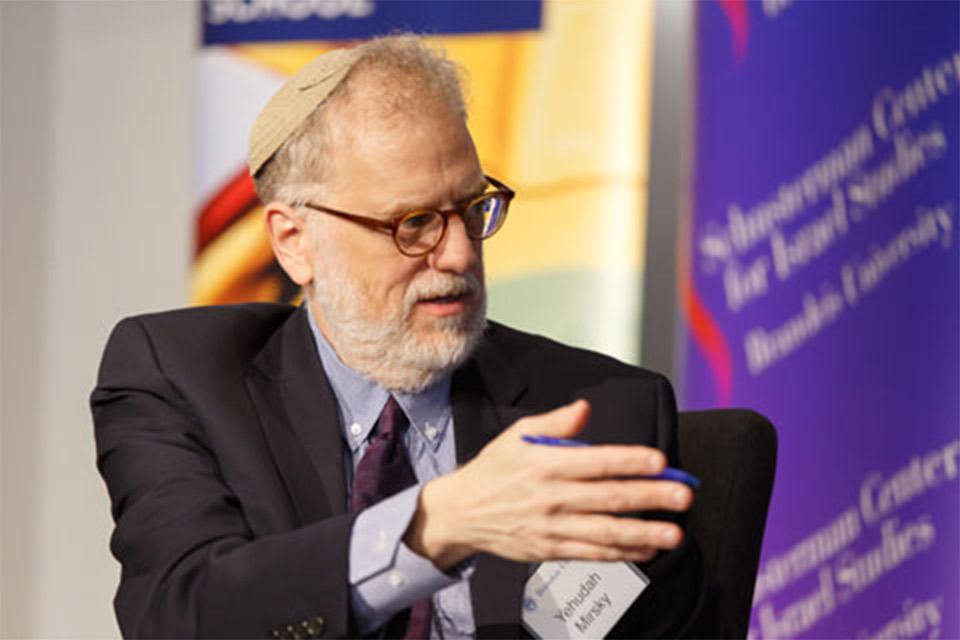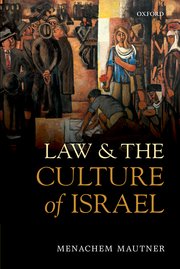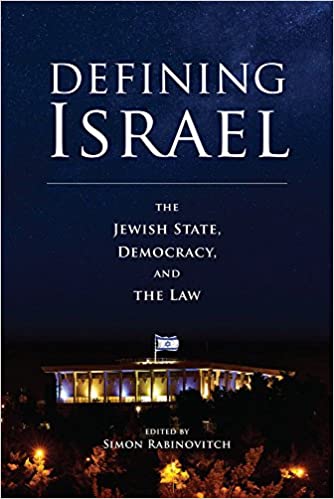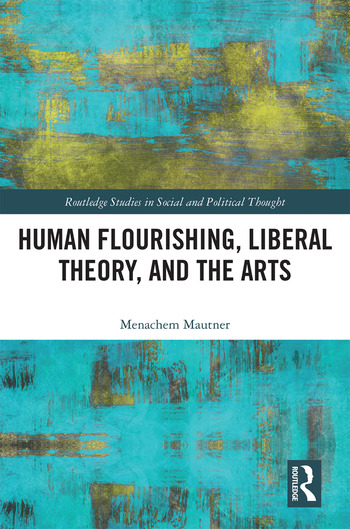Gleanings

Professor of Near Eastern and Judaic Studies at Brandeis and faculty member of the Schusterman Center for Israel Studies, Yehudah Mirsky opens our new series on recent publications in the field of Israel Studies
Amid global disruptions such as COVID, climate change and civil unrest (and those are just the few beginning with the letter “c”) scholarship marches on. Israel Studies is no exception, and, once again, new publications illuminate Israeli developments, the global trends of which they are a part, and help us sift between the two.
Two recent publications try to rethink familiar notions of liberalism and class in Israel, with stakes for discussions in other countries too.
Liberalism’s Crises in One Country
Joe Biden may have won the election, but the crises of liberalism that brought Donald Trump to power are not over, nor are they unique to the United States. Looking at liberalism's vicissitudes in different countries sharpens understanding of shared trends and distinctively local features. Comparative study is always a major scholarly tool, and the present moment raises its stakes.
Menachem Mautner, a distinguished legal scholar at Tel Aviv University, has recently published Liberalism in Israel: Its History, Problems and Futures, a wide-ranging study, offering pointed criticism of his own, liberal camp, out of desperate concern for its survival.
 In earlier, eye-opening, work on Israel’s judiciary Mautner explored how Israel’s Supreme Court, under the Presidency of its masterly, controversial Chief Justice, Aharon Barak, promoted a liberal judicial activism more far-reaching than its American model. Israel, of course, has no written constitution, but a series of (ungainly named) Basic Laws. One of them, passed jointly by Labor and Likud in 1992, was the Basic Law: Human Dignity and Liberty , incorporating into Israeli law international human rights principles and defining Israel as “a Jewish and democratic state.” Barak, in a series of brilliantly executed opinions, leveraged this Basic Law into a constitutional revolution, giving the Supreme Court a final say over vast swathes not only over parliamentary legislation, but even governmental policy-making.
In earlier, eye-opening, work on Israel’s judiciary Mautner explored how Israel’s Supreme Court, under the Presidency of its masterly, controversial Chief Justice, Aharon Barak, promoted a liberal judicial activism more far-reaching than its American model. Israel, of course, has no written constitution, but a series of (ungainly named) Basic Laws. One of them, passed jointly by Labor and Likud in 1992, was the Basic Law: Human Dignity and Liberty , incorporating into Israeli law international human rights principles and defining Israel as “a Jewish and democratic state.” Barak, in a series of brilliantly executed opinions, leveraged this Basic Law into a constitutional revolution, giving the Supreme Court a final say over vast swathes not only over parliamentary legislation, but even governmental policy-making.
Mautner convincingly depicted this judicial revolution as the struggle of a once-hegemonic Labor Party establishment, economically socialist and politically liberal, to hold onto what remained of its power. Increasingly defeated at the ballot box, seeing new religious and nationalist groups rise while core liberal values decline, the “former Labor hegemons” as he calls them, took to the courts to preserve what they saw as the fundamentals of Israeli democracy, and what their opponents saw as their own elitist cosmopolitanism. The ultimate reaction was 2018’s Basic Law: Israel as the Nation-State of the Jewish People which pointedly didn’t mention democracy, an omission that sparked powerful discussion, pro and con.

If this sounds familiar to American readers, it should.
In looking at the causes of Israeli liberalism’s decline, Mautner points to a number of causes for Israeli liberalism's decline.In this new volume, Mautner deepens his legal analysis, and expands his angle of vision to encompass larger questions of nationalism, economics, ethnicity, religion and culture. (One of the volume’s many rewards is his generous acknowledgement and citation of other scholars whose work has enriched his own.)
Some are familiar from elsewhere: the Left’s prioritizing identity politics over economic bread and butter issues; the dismantling of the welfare state and the rise of aggressively privatized economics, undermining equality, and embittering lower and working classes ripe for nationalist politics of resentment and religious retrenchment.
Some are distinctively Israeli: the Israeli Left’s inability to provide compelling answers to the security concerns of ordinary Israelis living within the Green Line, during the Second Intifada of 2000 and the smaller but traumatizing “knife intifada” of 2015; the very Ashkenazi character of Israeli liberalism, which regularly has trouble not only connecting with, but hiding its contempt for, the Mideastern ethnicity and traditionalism of Israel’s many Sephardic Jews; and the overwhelming and focus of the Israeli Right and Religious Zionism on Zionism’s territorial dimension, especially as regards the West Bank, which colors discussions of Israeli politics and policy within the Green Line.
 And another, central crux: contemporary liberalism's difficulty when it comes to engaging with religion (in this case Judaism) in fostering thick ties of community and belonging. Here, Mautner urges the relinquishing of autonomous, regularly atomistic, liberal individualism so familiar to America, and the adoption of what he has elsewhere discussed as the liberalism of human flourishing. By this dispensation, yes, the well-being of the individual is at the chief goal of politics, but that well-being means enabling citizens to actualize themselves not only as citizens and consumers but as members of communities, including of ethnicity, religion and culture.
And another, central crux: contemporary liberalism's difficulty when it comes to engaging with religion (in this case Judaism) in fostering thick ties of community and belonging. Here, Mautner urges the relinquishing of autonomous, regularly atomistic, liberal individualism so familiar to America, and the adoption of what he has elsewhere discussed as the liberalism of human flourishing. By this dispensation, yes, the well-being of the individual is at the chief goal of politics, but that well-being means enabling citizens to actualize themselves not only as citizens and consumers but as members of communities, including of ethnicity, religion and culture.
This in turn suggests looking for models of liberalism less to American unfettered capitalism and more to Western European social democracy; moving towards republicanism while recognizing that different communities, Jewish and Arab, will have different senses of the common good; allowing for more localized arrangements regarding religious affairs; resurrecting ideas of liberal nationalism as an alternative to chauvinist nationalism; restoring judicial credibility; and finding avenues of good faith engagement with religious thinkers and ideas without compromising on fundamental freedoms. And all emerging, as organically as possible, out of the soil of Israeli culture and society.
In urging a more liberal nationalism Mautner by no means diminishes Israel’s conflict with the Palestinian, or its centrality to the dynamics of Israeli society present and future.
"The task facing Israeli liberals," he writes, "is enormous. They must on the one hand fight for liberalism’s continued existence in Israel. On the other…they must…adopt liberalism of flourishing, republicanism and multi-culturalism … and work to bring to a close the territorial element of Israeli nationalism, to give space for its other themes."
In other words, key to ending the grief of occupation isn’t discarding nationalism but liberalizing it (as many early Zionist thinkers, including Herzl himself, sought to do). And liberal pluralism, thought through to its deepest intentions, also means a plurality of liberal ways of life. Here, as elsewhere, diversity is key to survival.
A Touch of Class
Class analysis has in recent decades been something of a stepchild of the social sciences. Categories of race, gender and identity have come to the fore, especially in Israeli sociology, in which post-Colonial Studies have held powerful sway, not least due to Israel’s endlessly unsettled relations with Palestinian Arabs. The most recent issue of Megamot, an interdisciplinary journal of the Social Sciences, offers a cluster of articles seeking to reinvigorate class analysis in Israeli sociology of religion. Given the renewed global emphasis on economic inequalities as a leading driver of political unrest and social upheaval, and the dynamic place of religion in contemporary politics, this renewed conceptual toolbox comes not a moment too soon.
This volume though, was long in the making. It is the harvest of a research group at the Van Leer Jerusalem Institute led a decade ago by two remarkably creative Israeli sociologists, Nissim Leon and Shlomo Fischer.
Their research group and this special journal issue seek to revive the idea of class in both its senses – both as economic differentiation and a marker of social and cultural status – as a central and independent category of analysis and not necessarily as embedded in categories such as ethnicity or gender.
In his Introductory essay, Fischer illustrates three different sociological traditions of class analysis and the kind of light they can shed: Thus Emile Durkheim’s seeing “division of labor” as the fulcrum of varying values, beliefs and identities, and the kinds of languages that go with them, illuminates how the rationalized, privatized economic language of the Ashkenazi middle class gives rise to one kind of religious experience and understanding, and the hands-on group labor of Mizrahi tradesmen, to another. Max Weber’s distinction between economic class and status helps explain how a slowly but steadily rising Mizrahi middle class, frustrated at its lack of status in elite society, turns to religion and nationalism. And last but not least, Marxian analyses of religion’s power to mobilize the lower and working classes go a long way towards explaining the rise of a central and insufficiently understood and underestimated player in Israeli society, Shas.
Other studies in this rich volume explore historical relations between Jews, Judaism and capitalism (David Sorotzkin), class tensions within Israel’s Christian Arabs (Merav Mack), the upper middle class basis of Israel’s thriving New Age spirituality (Rachel Werczberger and Dana Kaplan), the religion of Israel’s Army Non-Commissioned Officers (Chen Bram and Shlomo Fischer), the gender zealotry of Israel’s ultraorthodox (Sima Zalcberg), the geography of class stratification in ultraorthodox cities (Lee Cahaner), the conflicting imperatives of religious study and demanding technocratic and scientific careers among Religious Zionists (Nissim Leon), the status of Mizrahim in Religious Zionist Education (Malka Katz); and, last but by no means least, the place of Israel’s “status quo” on matters of religion and state in maintaining Israel’s class structures.
This attempt of Fischer and Leon’s, in truth, met with some resistance in the field, due to the predominance of post-structuralist and post-colonialist orientations in Israeli critical sociology. As Fischer writes in his Introduction, “one cannot reduce people’s lives to the Israel-Palestine conflict, nor to the identity politics of nationalism, ethnicity, or religion.” This was hard for many to take and accounts, one suspects, for this marvelous collection’s having taken so long to find a venue in print.
Its publication by the veteran social science journal Megamot perhaps signals a new openness to more pluralistic and diverse theoretical orientations.
Yet this latest issue of Megamot, is, sadly, its last, as the journal’s sponsoring institutions can no longer maintain its funding, ironically demonstrating the editor’s emphasizing the salience of economics in intellectual life. One can only hope that the terrific essays gathered here will spark similar efforts in other venues, and not be this intervention’s swan song.
A Closing Thought
Israel Studies, like all endeavors, has the defects of its virtues. An overwhelming focus on one place and its history can foreclose the broader contexts which not only help account for that one place’s own story, but can cast light on other places’ stories too. The publications briefly discussed here marvelously illustrate how in-depth study of one place, when done with scholarly self-awareness and care, can help us understand other places and their stories, past, present, and, with all due humility, and more humility on top of that, their possible futures.